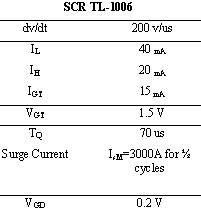There are different ratings that are specified by the device manufacturers and they are available in SCR manuals.The designer must make use of this data in order to select a device which has adequate ratings.The specified ratings should not be exceeded in order to operate SCR reliably. In this section some of the important ratings have been discussed.
• Latching Current (IL): Latching current IL is the minimum anode current required to maintain thyristor in ON state immediately after thyristor has been Turn ON and the gate signal has been removed
• Holding Current (IH): Minimum anode current below which device stop conducting and return to its off state usually this value is very small in mA.
• Forward Breakdown Voltage (VBO): If anode to cathode voltage VAK is increase to sufficient large value, the reverse bias junction J2 breaks this is known as Avalanche Breakdown and corresponding voltage is called as forward breakdown voltage VBO.
• Reverse Breakdown Voltage (VBR): If reverse voltage is increased During reverse blocking if Ig = 0 then only reverse saturation current (Is) flows until the reverse voltage reaches reverse break down voltage (VBR). At this point current starts rising sharply. Large reverse voltage and current generates excessive heat and destroys the device.
• dv/dt: dv/dt rating of thyristor indicates maximum rate of rise of anode voltage that will not trigger the device without any gate signal.
• di/dt: di/dt rating of thyristor indicates maximum rate of rise of anode to cathode current.
• Surge Current: It specifies the maximum allowable non repetitive current the device can withstand. The device is assumed to be operating under rated blocking voltage, forward current and junction temperature before the surge current occurs. Following the surge the device should be disconnected from the circuit and allowed to cool down. Surge currents are assumed to be sine waves of power frequency with a minimum duration of ½ cycles. Manufacturers provide at least three different surge current ratings for different durations.
• Gate current to trigger (IGT): Minimum value of the gate current below which reliable turn on of the thyristor cannot be guaranteed. Usually specified at a given forward break over voltage.
• Gate voltage to trigger (VGT): Minimum value of the gate cathode forward voltage below which reliable turn on of the thyristor cannot be guaranteed. It is specified at the same break over voltage as IGT.
